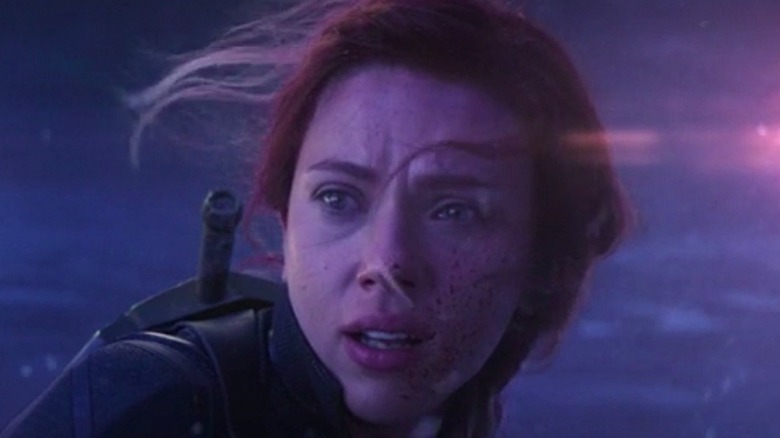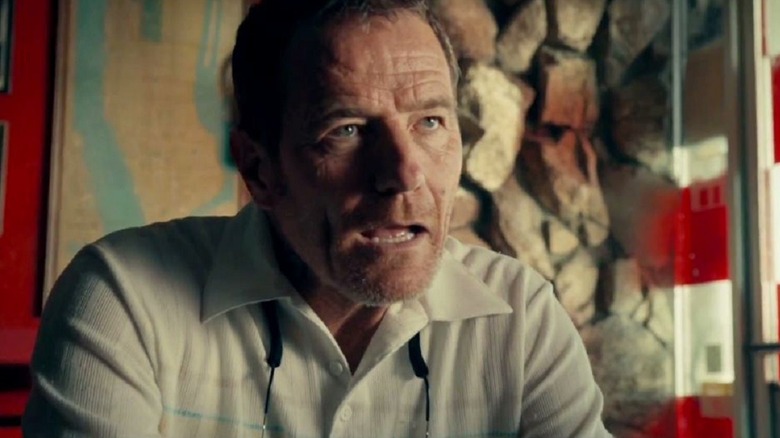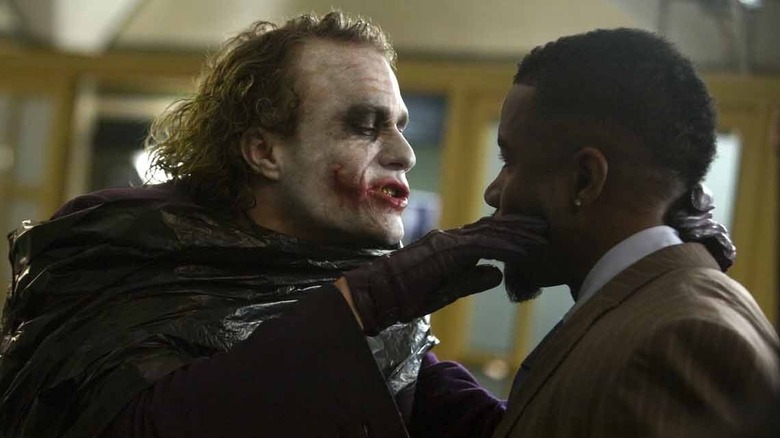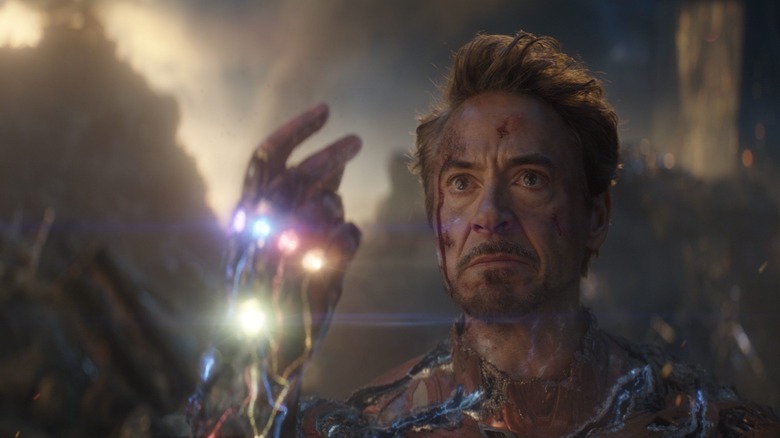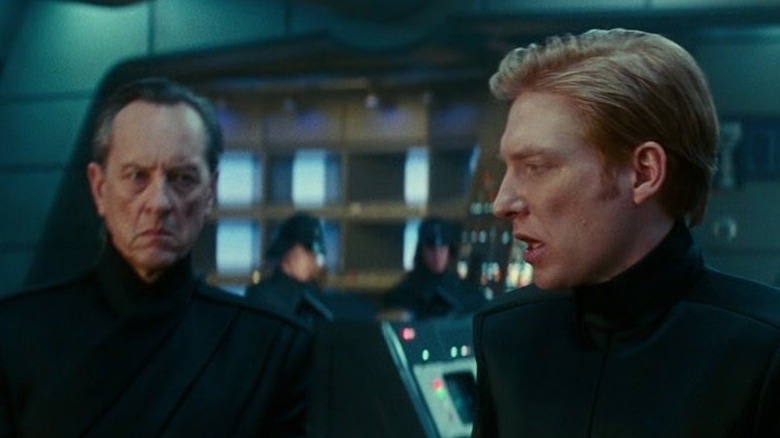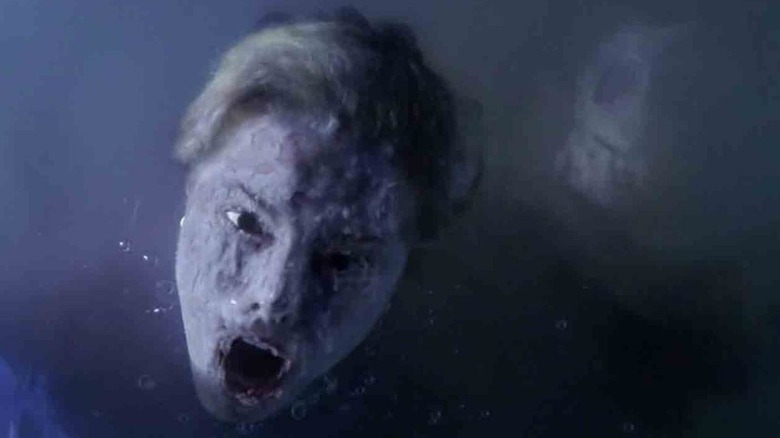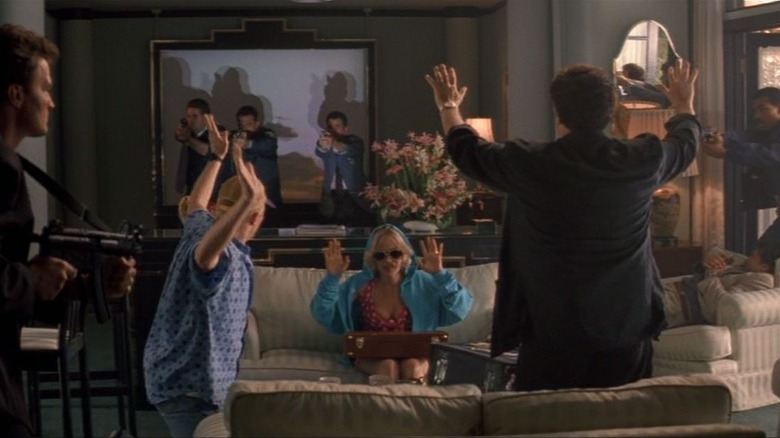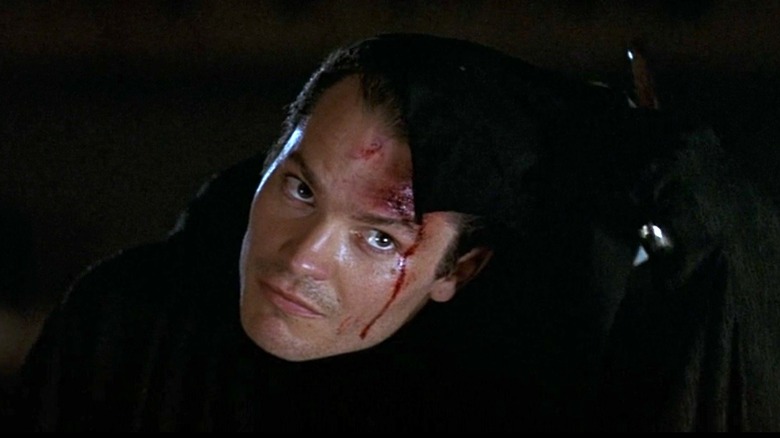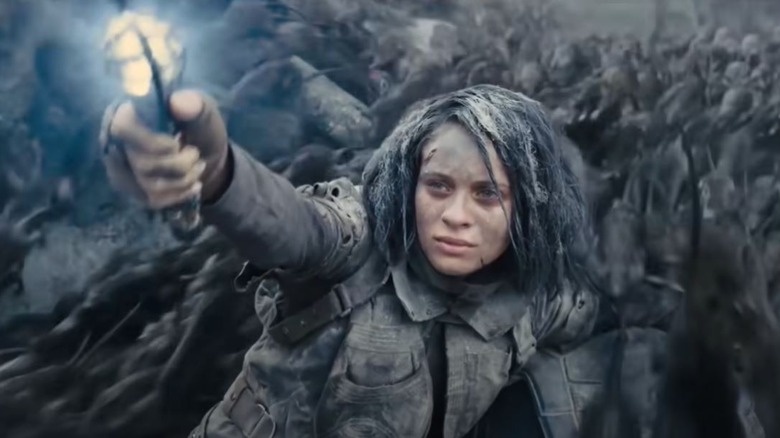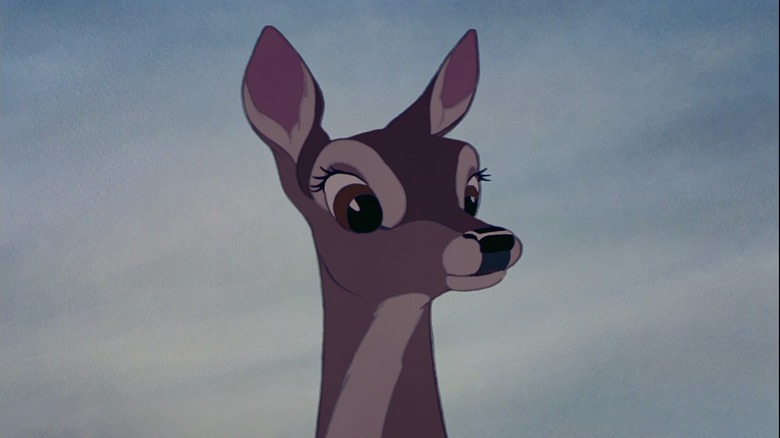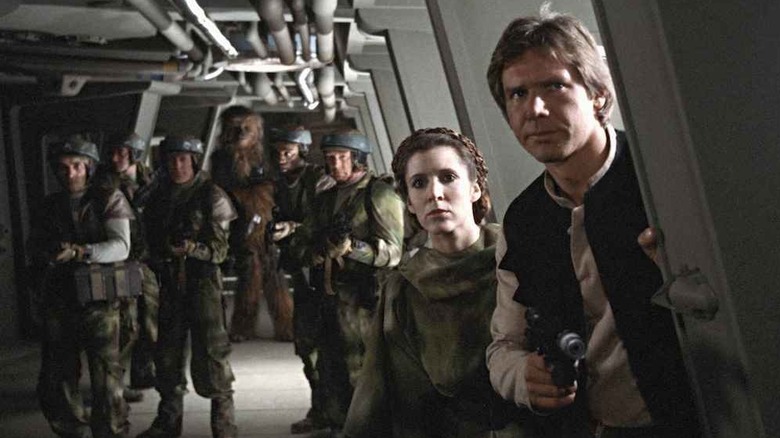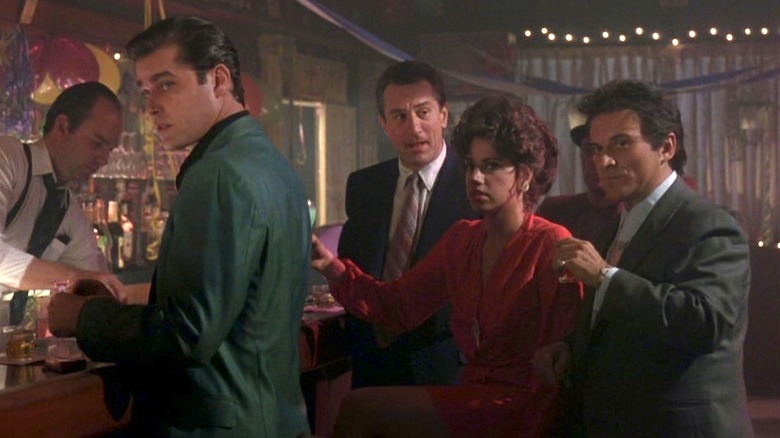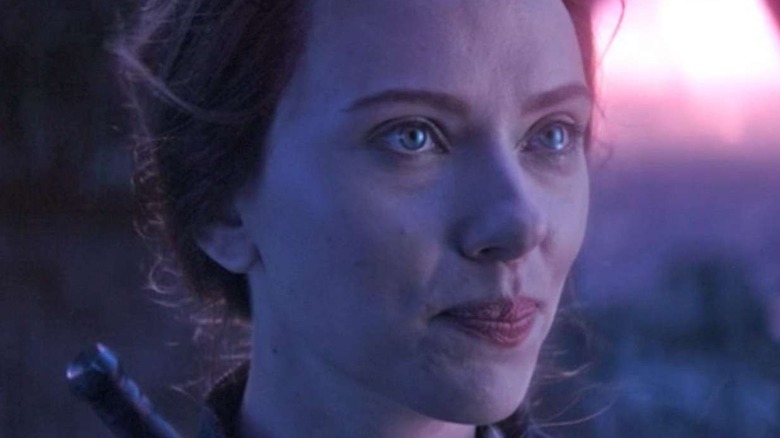Movie Deaths That Were Completely Different In The Original Script
Even the most hard-hearted movie fan can admit that they've been moved by at least one character's death. (A certain cartoon deer springs to mind. Or maybe a certain quip-loving superhero.)
Killing a main character is a pretty big deal to filmmakers, too. And sometimes, even side characters are given the honor of a memorable death. Working out how to film these scenes in a way that will resonate with audiences takes some trial and error. Especially when the climax of the movie or even an entire franchise is at stake. It's not unusual to see the death scene change between script and screen, which means that some of the most poignant moments in movies almost looked very different.
From an unseen battle for the chance make the ultimate sacrifice, to a friendlier approach to an assassination, and a change of heart over a fan favorite supervillain, these movie deaths looked much different in the original script. Spoilers ahead.
Bryan Cranston changed this character's death scene
Depending on your TV preferences, you may know Bryan Cranston as lovable weirdo Hal from "Malcolm in the Middle," or as megalomaniacal chemistry-teacher-turned-meth-kingpin Walter White in "Breaking Bad." Whether White would die was a matter of debate throughout the show's run. (Don't worry: There are no spoilers about the ending of "Breaking Bad" here.) Cranston was happy with what ultimately happened — but he did intervene to change the fate of a different character.
Cranston played chop shop owner Shannon in "Drive," the 2011 heist movie directed by Nicolas Winding Refn. In the final act, Shannon is killed by Bernie (Albert Brooks), who has to dispatch everyone involved in a robbery before word gets back to the Mafia. Unfortunately for both men, prior to this sad incident, they actually got on pretty well. So when Cranston read in the original script that Bernie was going to kill Shannon from behind, "with a garroting wire and he chokes and cuts me to death," as he told the Hollywood Reporter, he felt it didn't make sense for their relationship.
Instead, he pitched Refn and star Ryan Gosling a still-shocking but theoretically merciful murder: Bernie slices Shannon's wrist and tells him he'll fall asleep, and he won't feel any pain. Cranston suggested Bernie lay Shannon down and put a blanket over him. That part was left out, but Refn loved the rest of his idea so much he changed Shannon's death scene to Cranston's version.
This actor didn't even know that his character died in The Dark Knight
The cut-throat (or mouth) world of movie-making means that sometimes actors don't even find out that their character has been killed until they rock up to the premiere and see the final result.
That happened to Michael Jai White, who played Joker-antagonizing gangster Gambol in "The Dark Knight."
In the version of the movie that made it to the big screen, the Joker (Heath Ledger) uses a bounty Gambol has put on him to smuggle his way into Gambol's headquarters. Holding a knife in Gambol's mouth, the Joker tells him a (probably fake) story of how he got his scars.
We don't see what happens next, but based on the reaction of one of Gambol's henchmen and the music, it's not good. Finally, from behind, we see Joker drop Gambol, who falls limp to the floor.
If that sounds a little ambiguous, White agrees. He told the Hollywood Reporter that originally, Joker cut Gambol's face but didn't kill him, and he had more scenes later in the movie. "I never shot a death scene," White says. Presumably that means he wasn't the one the Joker dumped on the floor. White added: "The character wasn't supposed to be gone. That is something that happened in editing later." Talk about adding insult to injury.
This Avenger's final quip was changed last minute
Simultaneously killing off a major character and wrapping up a beloved franchise are heavy storytelling burdens to carry. So it took a while for the "Avengers: Endgame" filmmakers to figure out how to say goodbye to Iron Man (Robert Downey Jr.) as he saves the world from snap-happy Thanos (Josh Brolin).
Writers Christopher Markus and Stephen McFeely weren't always planning to kill off Iron Man. And when his death became — ahem — inevitable, they couldn't quite come up with final words that pleased everyone. At Comic-Con in 2019, McFeely told the audience that they wrote "all sorts of lovely dying words for Tony Stark," but Downey Jr. vetoed them all. He felt it would be better if his character — known for his constant bravado — was finally rendered speechless.
However, that plan changed slightly. Directors Joe and Anthony Russo credit editor Jeff Ford — like Iron Man, a veteran of the franchise — with coming up with the perfect final quip. At a Q&A, they recalled being in the editing room and realizing that Stark of Snark would never let Thanos have the final word. After trying "a million different last lines," Ford suggested Stark's response to Thanos' "I am inevitable" be a throwback to a line from the original "Iron Man," the movie that started it all: "And I am Iron Man."
Even then, not everyone was pleased. Downey Jr. had his own suggestion: "Oh snap!"
General Hux's death was originally even more controversial
The list of story decisions in "Star Wars: Episode VII," "VIII" and "IX" that have been criticized by longtime fans is lengthy. Among those complaints, some have taken the time to draw attention to the death of a pretty dislikeable villain. But the original scene may have been even more controversial.
In "Rise of Skywalker," General Hux (Domhnall Gleeson) is unceremoniously shot by Allegiant General Pryde (Richard E. Grant), after betraying the First Order. Hux helped several well-known Resistance heroes escape from certain death, just to get back at rival First Order leader Kylo Ren (Adam Driver). Some viewers felt this was a pretty weak reason for turning against his entire world view up to that point.
The final movie in the trilogy — then "Duel of the Fates" — was originally set to be directed by Colin Trevorrow, who left the project in 2017 over creative differences. His script later leaked online, and it revealed a different ending for Hux. Knowing that the First Order is doomed, Hux uses one of his personal collection of vintage lightsabers — a purple one, in fact — to kill himself. This is especially notable because it indicates a fascination with the Force, and because so far, only one person has wielded a purple lightsaber...
If you or anyone you know is having suicidal thoughts, please call the National Suicide Prevention Lifeline at 1-800-273-TALK (8255).
The creators of Jason X decided this death wasn't gory enough on the page
When you're working on the 10th installment of a horror series that's been around for over two decades, coming up with creative ways to kill off characters can be a nightmare (on whatever street). At least one scene in the script for "Jason X" — the 10th movie in the "Friday the Thirteenth" franchise — needed some extra gorification to really make it scream on screen.
The victim was intern Adrienne, played by Kristi Angus. Angus told Vice that in the original script, serial killer Jason (Kane Hodder) killed Adrienne by freezing her head in liquid nitrogen. However, by the time Angus arrived on set, the filmmakers had decided that that wasn't enough: He would also "smash her face in," as Angus put it.
The actress was up for it. "I honestly thought it was really cool," she says. She threw herself into filming, but unlike the character, the worst injury she sustained were a few bruises.
The scene became one of the movie's most critically successful moments (although that's not saying much.) Angus recalled that another famously bloodthirsty director gave it a nod of appreciation. "Even Quentin Tarantino was talking about ... how cool he thought it was," she told Vice.
Tony Scott changed Quentin Tarantino's True Romance script for this character's death
Quentin Tarantino wrote the screenplay for "True Romance," but Tony Scott (of "Top Gun" fame) directed the movie — freeing Tarantino up to make another script he'd written, "Reservoir Dogs."
This relay team approach led to some interesting shifts from page to screen. For one thing, in Tarantino's script, Clarence (Christian Slater) died from the bullet wound he sustained in the multi-party, feather-covered, finale shootout. Even more gut-wrenching, Alabama (Patricia Arquette) claimed she'd never really cared about him.
Scott shot this ending, but ultimately went with the one where Clarence survives and the couple has a child. Even Tarantino now agrees it's a better send off.
In his commentary on the movie, Scott also revealed that he changed that finale to give one character a more protracted death scene. In Tarantino's script, Wurlitzer (Michael Beach), a cop, is just another victim of the bullet-ridden showdown. But Scott gave the actor a chance to react to his character's imminent death.
Wurlitzer and his fellow officer, Dimes (Chris Penn), struggle to comprehend that he's been shot. Wurlitzer abandons his hiding spot and slumps down on the couch, tentatively feeling his wound. The slow score and the falling feathers add to the surreal feeling and poignancy of the scene. In a genre where side characters are usually just fodder for violent deaths, it's a humanizing touch.
This Scream 2 Ghostface was originally a victim... but that could be another twist
Most people who watch movies will never read the scripts they started out as. But in the case of "Scream 2," a portion of the screenplay was the first interaction people had with the movie — a much-anticipated follow-up to the 1996 hit "Scream."
In a documentary about the franchise, "Still Screaming," director and horror legend Wes Craven recalled that 30 pages or so were leaked online, revealing the intended killers and forcing a rewrite. In the leaked version, Ghostface killer Debbie Salt/Mrs. Loomis (Laurie Metcalf) had two gruesome assistants: Derek (Jerry O'Connell) and Hallie (Elise Neal), protagonist Sidney's (Neve Campbell) boyfriend and best friend respectively.
The character that ultimately ended up being one half of the Ghostface duo in the finished movie — movie nerd Mickey (Timothy Olyphant) — died in both versions: But in one he was a victim of the killers, and in the other, he's shot to death in self-defense by Sidney and Gale (Courtney Cox).
However, like all good horror stories, this one has a twist. Writer Kevin Williamson told Dread Central that the producers had predicted a leak, and the Derek/Hallie version was actually a decoy. Mickey would probably prefer this ending anyway.
James Gunn took this death out of his original script for The Suicide Squad
Killing off characters can create a lot of internal turmoil for screenwriters and directors — and sometimes their more merciful side wins the day.
We admit this a bit different than the other entries on this list, since the way that this character's on screen death differs from their scripted death is that they don't die in the final version. But it's an interesting example of the balancing act filmmakers have to manage between their emotions and the needs of the story.
James Gunn's 2021 comic book adaptation "The Suicide Squad" was praised for its unabashedly R-rated interpretation of what would happen if you unleashed a bunch of supervillains onto a problem. (It's a welcome change from the drama surrounding the 2016 version.) As you'd expect, the body count is pretty high, including members of Task Force X. But one character narrowly escaped, purely because Gunn couldn't bring himself to kill her.
In an interview with Variety, Gunn said that in his original ending, Ratcatcher 2 (Daniela Melchior) didn't make it. However, he changed his mind: "She was so sweet, I just felt like it was just too dark," he says. "I just couldn't [kill Ratcatcher 2]." You're welcome, Rat Hive.
This Disney death was nearly even more disturbing
If you had a childhood after 1942 that involved watching Disney movies, you probably remember the moment a certain young deer lost his mother to a hunter.
The "Bambi" scene starts with fawn Bambi and his mother discovering a patch of grass in the snowy forest landscape. They start happily munching, until the mother becomes aware of a hidden danger, and tells Bambi to run for safety. The camera hones in on the fawn as bullets ring out. Bambi's mom encourages him on, and then falls silent. Once he's out of danger, Bambi calls out, "Mother! Mother?" into the now falling snow. Instead of his mom, he's greeted by a huge stag, the Prince of the Forest, who tells him, "Your mother can't be with you anymore," and adopts the baby animal.
The death of Bambi's mom has become a cultural shorthand for emotionally devastating movie scenes. And it was nearly even worse.
Reportedly the original plan was to show Bambi's mom lying dead in a pool of blood. Watching the fawn slowly understand what's happened out of his and our sight is enough to choke up even the most cold-hearted moviegoer. Imagine combining that with the gore of a dead deer.
There was one silver lining to come out of this creator of early childhood nightmares. After receiving so much backlash, Walt Disney decided that "Lady and the Tramp" would not include a dead dog. You're welcome, Trusty.
This Star Wars character was supposed to die in Return of the Jedi
"Star Wars" doesn't shy away from killing off sympathetic characters: RIP Uncle Owen (Abraham Benrubi), Aunt Beru (Shelagh Fraser), Obi-Wan Kenobi (Alec Guinness) and Qui-Gon Jinn (Liam Neeson). However, one character made it further than he was originally supposed to — but not because the director suddenly developed a soft spot for him.
"Star Wars" producer Gary Kurtz worked on "Episode IV" and "V" and part of "VI." He told the LA Times that in the original outline for what became 1983's "Episode VI: Return of the Jedi," Han Solo (Harrison Ford) survived his run-ins with Jabba the Hutt and carbonite, only to die during a Resistance raid on an Imperial base (presumably similar to the Endor scenario in the final version).
However, as Kurtz tells it, franchise creator George Lucas changed his mind, deciding that he didn't want any of the main characters to die, at least partly because he worried it might affect toy sales. Released in 1978, the "Star Wars" toy line made $100 million in its first year.
Han scraped through to the next episode, four movies later: 2015's "The Force Awakens." But then he was murdered by his own son, Kylo Ren (Adam Driver). Kurtz bowed out much earlier. He was so frustrated with Lucas' soft-boiled new "Jedi" ending, which he felt drew too much on the plotline of "A New Hope," that he quit the production.
This Goodfellas victim wasn't supposed to survive the first scene
"Goodfellas" made it clear that sudden, violent deaths are par for the course in the Mafia. One such memorable scene appeared in the original shooting script, but much earlier.
In the final movie, Billy Batts (Frank Vincent) survives six years in prison, only to bust Tommy's (Joe Pesci) sociopathic ego (and another part of his anatomy) a little too hard at his "Welcome Home" party. With the help of Henry (Ray Liotta) and Jimmy (Robert De Niro), Tommy comes back when everyone else has left, and beats Batts to death.
The interaction between Tommy and Batts is pretty similar in the original script. Yes, the shoe shine box comes up. However, the scene is the very first of the entire film. It's followed by the trio's visit to Tommy's moms for burial supplies, and then by the scene that ultimately became the opener: their drive to bury Batts. As in the movie, this is interrupted briefly by a still-alive Batts, and the scene ends with Henry saying, "As far back as I can remember, I've always wanted to be a gangster."
By keeping the identity of the body in the trunk at the start anonymous, the movie ultimately creates a stronger sense of foreboding. Driving around with a body in the trunk seems pretty normal for these guys: it could be any of many victims in there. Either way, you pick up on Tommy's style much faster than Batts.
One Avenger originally got a more dramatic send-off
You probably already have feelings about that Black Widow Scene in "Avengers: Endgame."
Mini recap: During the time travel quest to capture all the Infinity Stones and call a mulligan on the battle with Thanos (Josh Brolin), Natasha Romanov, aka Black Widow (Scarlett Johansson), sacrifices herself so that Clint Barton, aka Hawkeye (Jeremy Renner), can collect the Soul Stone.
Many fans found the final version of the scene devastating. Black Widow had been with the "Avengers" franchise since 2010's "Iron Man 2," and some felt that she deserved to see out the final (final) battle. Or at least go down fighting.
For her part, when Johansson found out about her "Avengers: Endgame" sacrifice, she felt that it was fitting for her character. However, exactly how Romanov died changed between the script and the movie — and the original did involve a battle. Johansson told the BBC that she and Renner shot a longer sequence on Vormir, which had them battling Thanos' army to reach the cliff edge. As in the final version, they disagree over who should die, but Romanov fights her way to the edge first and jumps over.
Directors Anthony and Joe Russo eventually changed their minds. Johansson said they felt — and she agreed — that something more "immediate" would be "a more impactful experience for the audience." So they went back and shot the final version of the scene, which involves a longer goodbye between the two characters.
